Bosnian pot stew, known as bosanski lonac, is a delicious slow-cooked broth overflowing with a medley of meat and vegetables. Hailing from the Middle Ages, this stew is as symbolic of Bosnia as a nation as it is delicious. Shall we?

Jump to:
Background
Bosnian pot stew, known as bosanski lonac, is a dish crafted by Bosnian miners during the Middle Ages. Its name, "lonac," pays homage to the type of clay or ceramic pot traditionally used for its preparation.
The story goes that the miners would gather ingredients from their homes on their way to work. Everyone brought what they had: a vegetable, a piece of meat, herbs and seasonings...
Before they entered the mines, they'd light a fire, layer these ingredients in a clay pot, and leave the dish to simmer while they worked underground. When, hours later, they resurfaced for their only break of the day, their hearty well-deserved meal was ready.
A Personal Story
A few years ago, a BBC food journalist came over for dinner. He was traveling all over the country, sampling Bosnian pot stew in different places.
A heartwarming parallel was made. Bosanski lonac, he thought, with all its varied ingredients and ways of preparation, came together beautifully...
...just like Bosnia and Herzegovina and its people.
The dish once again breathed a life of its own.
Later, another BBC crew explored the dish further in their segment on travels through Bosnia.
Ingredients
Here are the most commonly used ingredients for bosanski lonac (Bosnian pot stew). This is by no means an exhaustive list! Many more ingredients can be added, and it's fine if you're missing a couple.
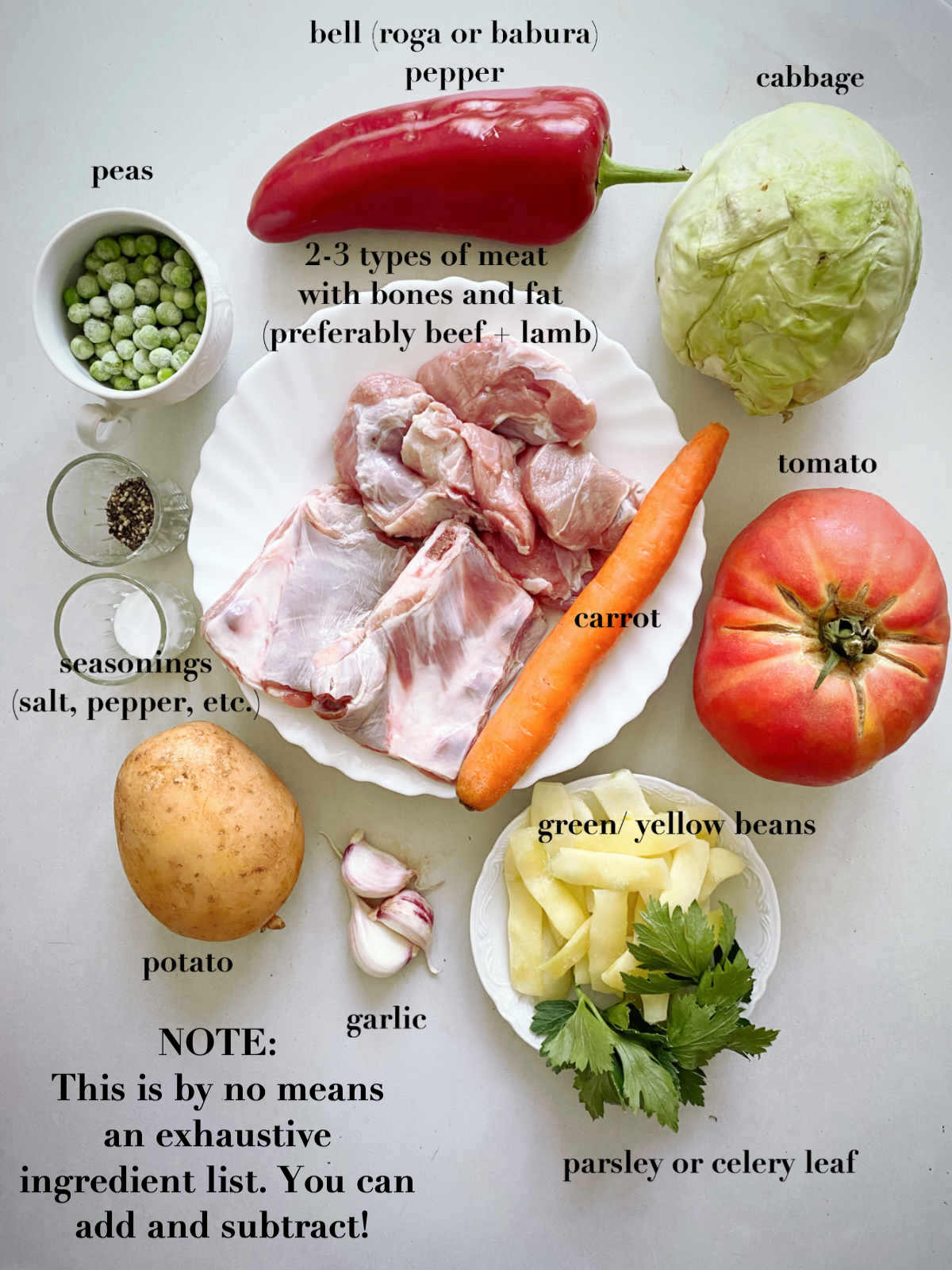
Meat:
Originally, all types of meats were used for bosanski lonac. Today it's usually, although not exclusively, made with beef and lamb cuts.
For the tastiest stew, choose at least two types of meat, three is even better. Pick a fatter cut. Adjust based on your eating preferences. For example:
- Lamb and beef,
- Beef and mutton,
- Beef and pork,
- Veal and beef, etc.
If you only have one type of meat that's fine, but try to choose two cuts. Like:
- Rib and chuck,
- Rib and shank,
- Shank and flank.
Finally, if you only have one type of meat you can still make this stew. However, it stands to be repeated. The meat should
- Have fat on it
- Bones are fine too.
Avoid: poultry, smoked, or processed meats!
Vegetables:
Vegetables for bosanski lonac are so varied you can run wild with your imagination!
Think nightshades and root veggies, as well as harder cruciferous too. Examples:
- Cabbage (green is better)*
- Carrots
- Onions
- Garlic (whole cloves)
- Potatoes
- Tomatoes
- Green and yellow beans
- Peas
- Green peppers (bell or babure)**
- Red peppers (bell or roge)**
- Chillies
- Parsnip
- Okra
- Zucchini
- Eggplant
- Cauliflower
- Broccoli
Warning!
The stew will be simmering for quite some time. Don't choose veggies that will be overly soggy after that much cooking. So, no other leafy greens.
*Using cabbage is a point of contention. Because cabbage has its own regional stew some cooks never use it in their Bosnian pot stew.
**Be conservative with peppers. They add acidity to the stew.
Herbs and Seasonings:
In true Balkan style, herbs and seasonings are simple.
- salt
- black pepper (peppercorns are best)
- a pinch of sugar
- parsley or celery (leaf)
- bay leaf is also known to make an appearance
- paprika
- Vegeta is optional
Optional Additions
As you cook Bosnian pot stew (bosanski lonac) over and over you'll discover the way you like it best. These are some things people do.
- Some people like to add 2-3 ounces of white wine.
- Others mix water with tomato sauce (3-6 ounces/ 100-200 milliliters).
- And then there are those that add 1-2 tablespoons of tomato paste and a teaspoon of sugar.
Equipment
Although originally cooked in a clay or ceramic pot (over an open fire), you can easily cook Bosnian pot stew (bosanski lonac) in a regular pot (on the stovetop) or in a Dutch oven (in the oven).
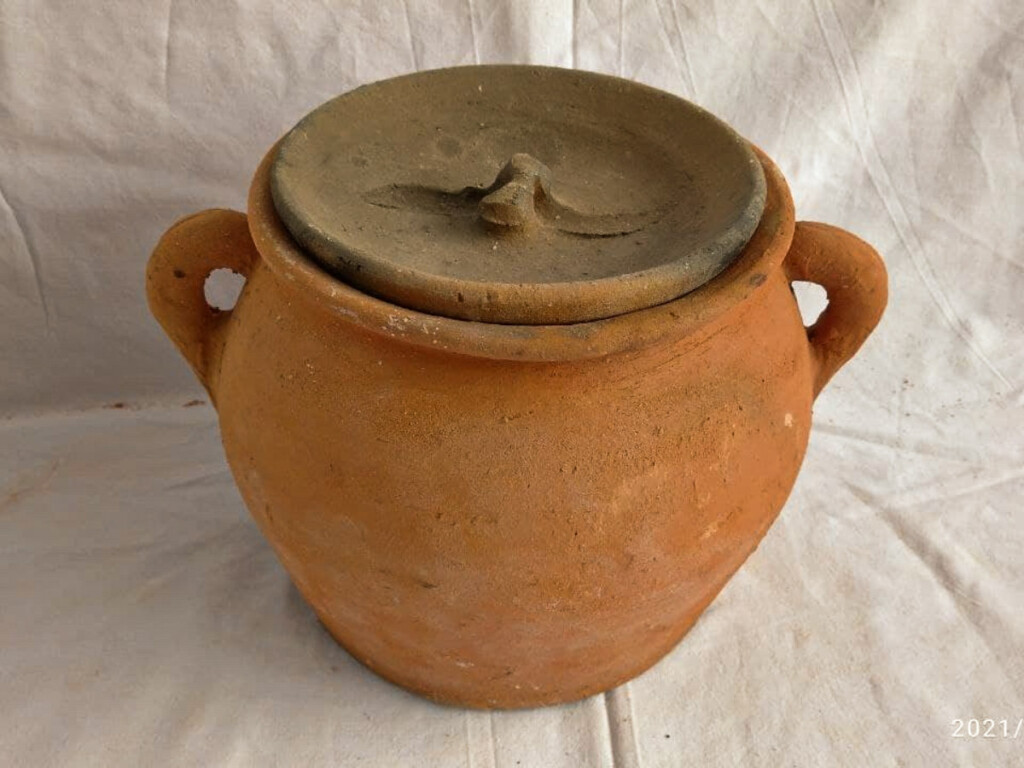
We like to use the clay pot in the oven as it gives the stew a certain "earthy" taste. However, the stew is phenomenal any way you cook it!

If you're putting it in the oven and don't have a lid, seal the pot with parchment paper and twine.
Instructions
Here are the instructions for making Bosnian pot stew (bosanski lonac). As noted in the equipment section you can cook it on the stovetop or in the oven. The trick is not to stir it.

Step 1 (Bosnian pot stew/ bosanski lonac). Putting the ingredients together.
Choose a clay, ceramic, or regular cooking pot.
Layer the ingredients into your pot one by one (keep the meat on the bottom), add the seasonings in between, and top it off with water (or water + tomato sauce).
Add just enough water to touch the vegetables on top, but not to cover them completely. The meat (especially fattier cuts) and vegetables release their juices as they stew, making the broth wonderfully rich. (This is why we don't overpower it with liquid.)
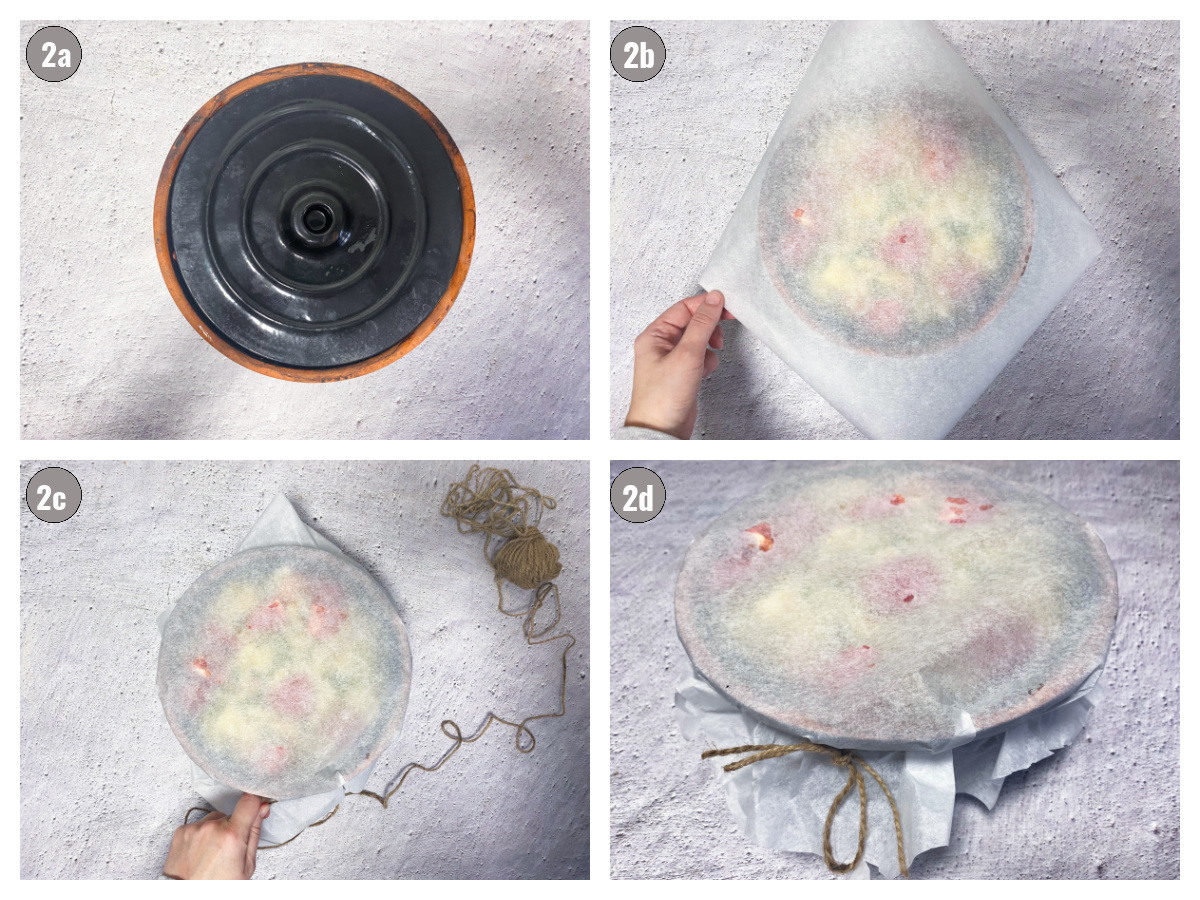
Step 2. (Bosnian pot stew/ bosanski lonac) Covering the Pot.
After adding water, cover your pot. If you don't have a lid, use parchment paper and twine then tie the paper around the top of the pot. Don't lift the lid or parchment paper during cooking. The stew shouldn't be stirred.
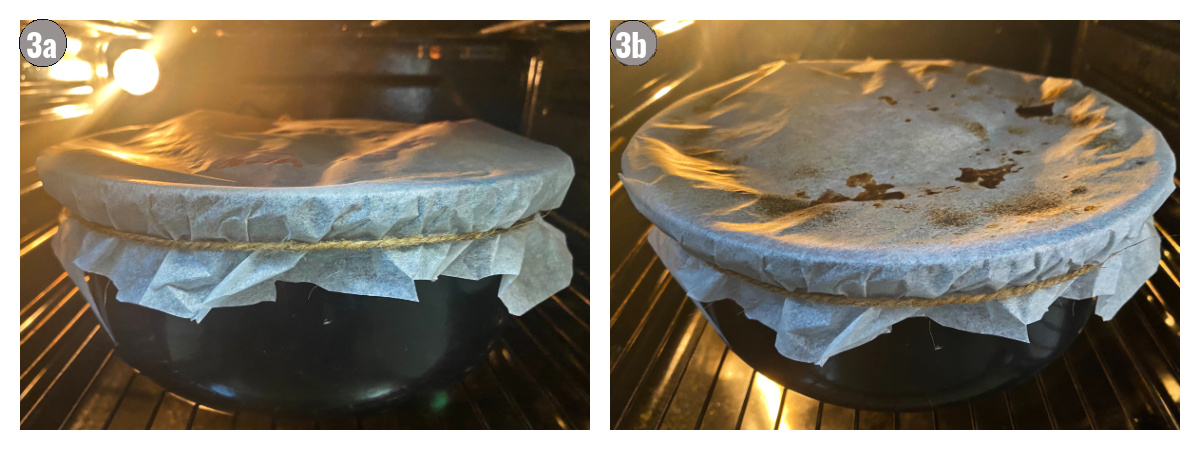
Step 3. (Bosnian pot stew/ bosanski lonac) Cooking.
Now choose your cooking method. If cooking in a clay pot you can cook the stew in the oven, or on the stovetop. (Clay pot + oven is our preferred method.) If cooking in a Dutch oven, you can also cook it in the oven or on the stovetop. If cooking in a regular pot, cook it on the stovetop.
Simmer the dish on low (or about 350°F / 180°C) for about 2-4 hours. (We find 3 to be that sweet spot!)
Note: newer Bosnian pot recipes call for braising the meat to seal in the juices first. Our recipe is based on the old-fashioned way of making this stew.

Expert Tips
Bosanski lonac is a flexible dish. You can make it with different ingredients, and cooking times, and surprisingly, it always turns out to be incredible.
However, there are three secrets to making a perfect Bosnian pot.
- Combine at least a few vegetables,
- Choose 2 to 3 greasier cuts of meat (preferably with some bones), and
- Simmer the stew on low heat for several hours.
Bonus tip: chunk the ingredients up!
How to Cook in a Clay Pot
If you decide to go for a clay pot, here are a few things to remember when cooking in it.
- Prior to use, hand wash the clay pot thoroughly and soak it in water for 30 minutes to prevent potential breakage.
- After washing, ensure it's completely dry, then coat it with butter, lard, ghee, or goose fat.
- Avoid adding oil or fats as clay pot cooking relies on slow steaming.
- After layering the ingredients, place the clay pot in a cold oven and let it heat up with the oven to prevent breakage.
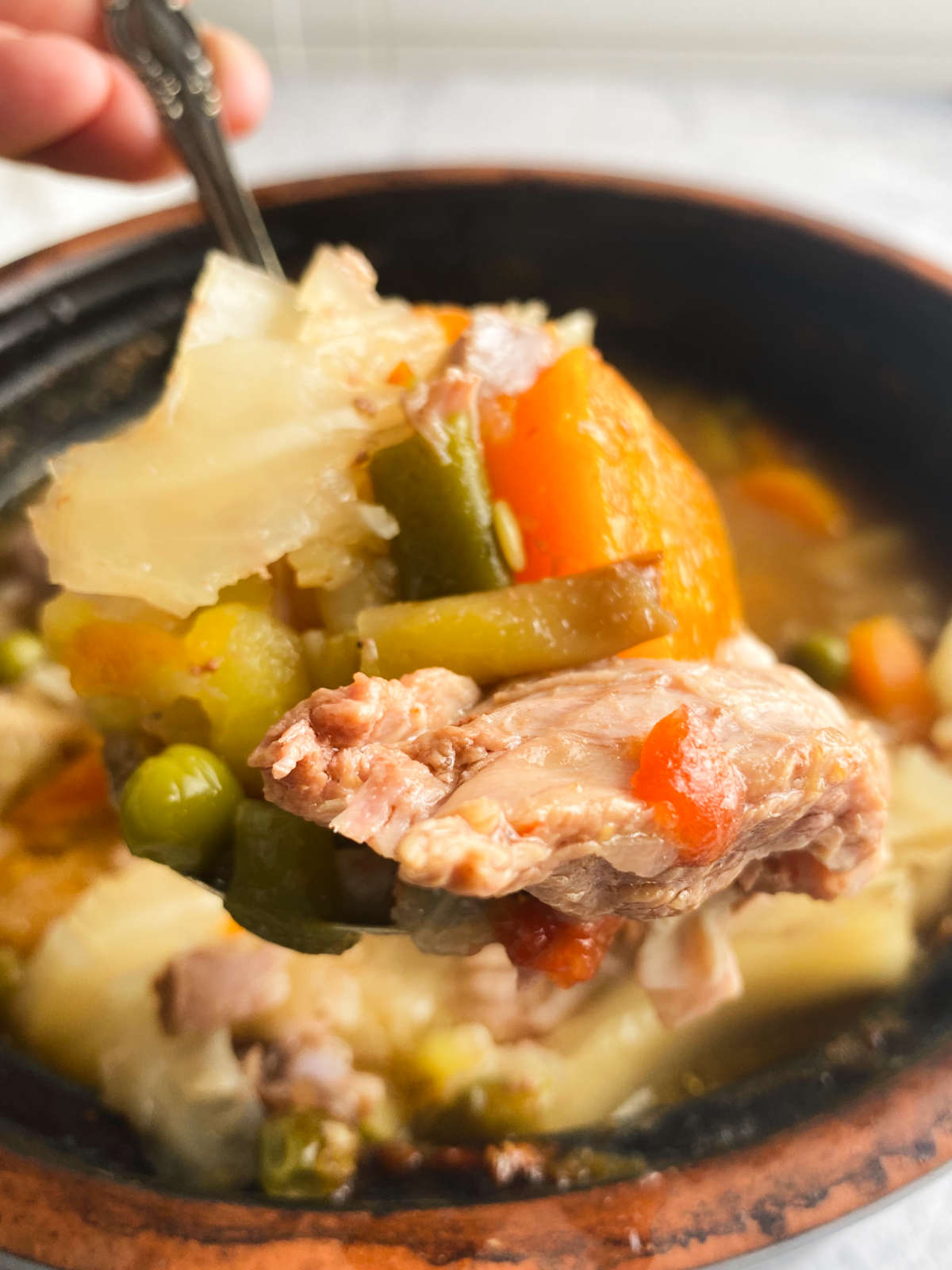
Recipe FAQs
It's up to you. We don't. We like to make it as close to the original stew as possible. The point of the stew is for the meat to release its juices which mix with the juices released by the vegetables. This method gives the dish a special, memorable taste and aroma.
Bosnian pot stew is a dish hailing from the Middle Ages, therefore all kinds of meats are and have been used to make the stew. Today it mostly depends on the meat preferences and needs of the people who are making it.
However, we do recommend using at least two types of meat, (for example: lamb and beef, mutton and lamb, or beef and pork), as it really makes the difference in the flavor.
Absolutely! In fact, clay pots have been used in cooking for thousands of years. They help the dish achieve a homey, earthy flavor. In fact, most people like clay pots so much, they get one for cooking as soon as they try a dish made in one.
Anything! Vegetables, meat, seafood, fish, stews, soups, sauces, ratatouille, rice, polenta, and more.
They can. However, soaking it in water for 30 minutes ahead of use, and then placing it in a cold oven eliminates this possibility. Furthermore, when you're storing it, make sure it's at room temperature. (Clay pots are known to crack in high summer heat and freezing cold.)
Handling
- Serving: Serve warm alongside homemade bread, or pogacha. Fermented salads like turšija or cabbage go great with this stew.
- Storing: Let the stew cool down completely, then transfer to fridgeware. Store in the fridge for up to 3 days. In fact, the stew is best a day or two after it's made.
- Reheating: The best way to reheat it is on the stovetop, on low, for at least 15 minutes, (or until it's hot). Otherwise, reheat based on your preferences. Add ½ cup of water if necessary.
- Freezing: We're not fans of freezing this stew. Freezing the veggies that have been cooking for a while, and then thawing them, makes them mushy. However, if you must freeze it, let the stew cool down completely, then transfer it to freezerware. Store in the freezer for up to 2 months.
More Stew Ideas
Although we are impartial to Bosnian pot stew (bosanski lonac), we are absolutely in love with making and eating stews. Check these out!
Thoughts?
If you make today's Bosnian pot stew (bosanski lonac) and like it, please consider leaving a ⭐️⭐️⭐️⭐️⭐️ (5-star) rating. This will help others find the recipe more easily!
You can also leave a comment, I read EVERY one! Finally, if IG is more your thing, consider tagging us @balkanlunchbox.
Prijatno and bon appetit!
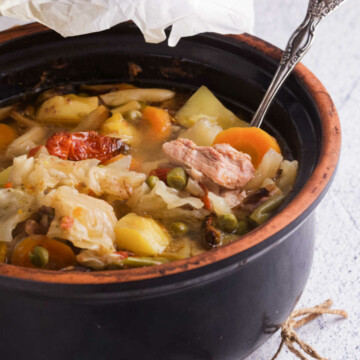
Bosnian Pot Stew (Bosanski Lonac)
Ingredients
Meat
- 2-4 pounds two, preferably three, types of meat (fatter cuts) examples: mutton, lamb and beef, beef and mutton, lamb and beef, beef and pork, or veal and beef; If you have only one type of meat, choose two different cuts like rib and chuck, shank and flank, etc. Chunk the meat.
Vegetables
- 1 cabbage head (green) smaller, cut into 8-10 pieces
- 1-2 yellow onion(s) quartered
- 3-4 garlic cloves (whole) peeled
- 3 carrots large, peeled, diced
- 8 ounces green or yellow beans cut into 1 inch pieces
- 4 ounces peas
- 3-4 potatoes (Russet or yellow) large, peeled and diced
- 3-4 tomatoes large, skinned, and diced, or an 8oz can
- 2-3 bell peppers cut into chunks, (local peppers babure and roge work also)
Herbs and Seasonings
- 1 teaspoon salt
- 1 teaspoon black pepper peppercorns are best
- 3-4 strands of parsley whole or about 1 cup chopped
- 1 teaspoon paprika
- 1-2 tablespoons stock powder or Vegeta or 1 bouillon cube crushed
Optional Additional Ingredients
- 3-4 ounces okra (dry or fresh) if fresh, cut into rounds
- 1 zucchini cut into chunks
- 1-2 1-2 small chillis diced
- 1 eggplant small, peeled, diced
- few cauliflower and broccoli florets
- 3-4 ounces white wine instead of tomato sauce, combined with water
- 3-6 ounces tomato sauce instead of white wine, combined with water
- 1-2 tablespoons tomato paste
- 1 tablespoon sugar if using tomato sauce/ tomato paste
- 1-2 bay leaf
Instructions
- (Layering the ingredients.) Choose a clay pot, a ceramic pot, a Dutch oven, or a regular cooking pot. Layer the ingredients into your pot one by one (keep the meat on the bottom). Add the seasonings in between. Top it off with water (or water + tomato sauce). Add just enough water to touch the vegetables on top, but not to cover them completely.
- (Covering the pot.) Cover the pot. If you don't have a lid, use parchment paper and twine, then tie the paper around the top of the pot. Don't lift the lid or parchment paper during cooking. The stew shouldn't be stirred.
- (Cooking.) Choose a cooking method based on your pot. If cooking in a clay pot, ceramic pot, or a Dutch oven, transfer the pot to the oven. Cook at 350°F (180°C) for about 2-4 hours (3 is optimal). (You can even go lower with the temperature.) If cooking in a regular pot, cook it on the stovetop on low for 2-4 hours (3 is optimal). Don't remove the lid or parchment paper, and don't stir.
- (Handling.) Serve warm. Store by letting the stew cool down completely, then transfer to the fridge for up to 3 days. The stew is best 1-2 days after it's made. Reheat on the stovetop, on low, for at least 15 minutes, (or until it's hot). Otherwise, reheat based on your preferences. Add ½ cup of water if necessary. Freeze (we don't recommend it!) by letting the stew cool down completely, then transfer it to the freezer for up to 2 months.

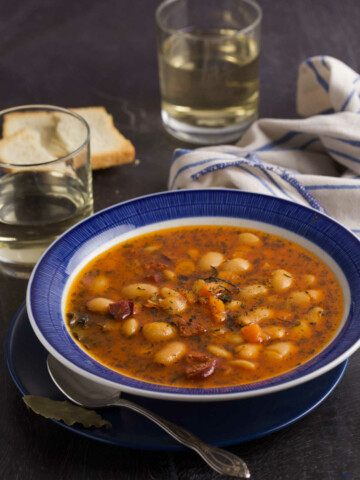
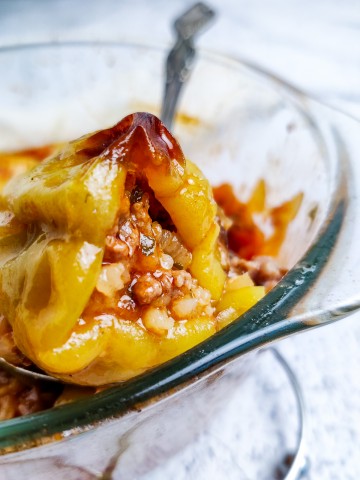
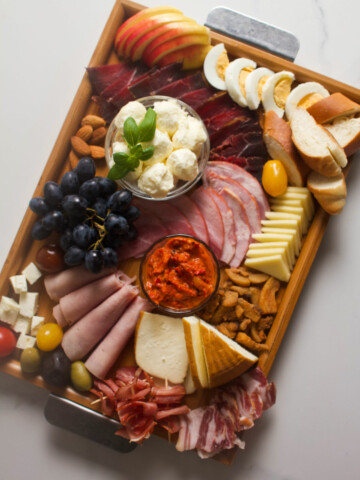
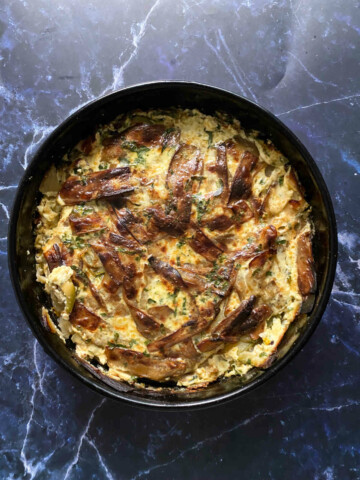
Ashley says
I'm all about the hearty stews this time of the year - looks wonderful!
aida says
Thanks Ashley! 'Tis the season for comfort food.
Kelley @ Chef Savvy says
I love stews this time of year and this one looks absolutely amazing!
aida says
Kelley, welcome! Thanks. It's the perfect time for some comfort food. 🙂
ana says
recipe looks good, I've seen people put tomato paste and add ajvar as well. what do you think?
Aida says
Sure, why not! We're all about adjusting the taste until you find the one you like.
Sandra says
Hi there! How could I cook this in an instant pot?
Cant wait to try it!
Aida says
Hi Sandra,
This article describes how to convert a regular recipe to an instant pot. Good luck! Report back how it turns out.
Happy cooking!
https://shorturl.at/3XYRT